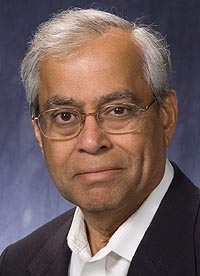Dr. Ken Natesan
The ScienceDaily article Networks Of Metal Nanoparticles Are Culprits In Alloy Corrosion said
“Oxide scales are supposed to protect alloys from extensive corrosion, but scientists at U.S. Department of Energy’s Argonne National Laboratory have discovered metal nanoparticle chinks in this armor.Oxide scales develop on the outer surface of alloys at high temperatures creating a protective barrier that keeps destructive carbon-bearing molecules from slipping into the alloy. The diffusion of carbon into oxide scales should be negligible, but studies have shown that carbon can sneak through the oxide line of defense leading to brittleness and corrosion.
‘The United States loses four percent of the gross national product due to alloy corrosion,’ Argonne Distinguished Fellow Ken Natesan said. ‘A network of continuous metal nanoparticles allow the carbon to dissolve and diffuse through the protective oxide scales without the need of a crack or a pore.’”
Ken Natesan, M.Sc., Ph.D., MBA, FASM, FNACE is Section Manager, Nuclear Engineering Division and Argonne Distinguished Fellow, Argonne National Laboratory. He has created more than 350 publications/presentations and has been awarded multiple patents. He is on the Editorial Board of International Journal of Refractory Metals and Hard Materials.
Ken has been a principal investigator in corrosion and mechanical property areas and has developed extensive research, development, and design information. In his capacity as a leading scientist, he has been actively involved in the development of numerous future materials researchers, such as staff scientists, postdoctoral appointees, visiting scientists from industries, universities, and from countries such as Poland, Italy, Mexico, Japan, Netherlands, India, Germany, South Korea, and Taiwan. He has also been a mentor involved in the development of high school and college students who aspire to become scientists in materials/corrosion research.
His research interests include:
- Materials performance in advanced nuclear reactors
- Materials behavior in current light-water reactors
- Materials development and understanding for advanced coal-fired systems
- Surface modification to improve corrosion and wear resistance
- Development of ultra high-temperature alloys
- Materials for complex and extreme environments
- Basic research leading to solutions for practical problems
Ken coauthored Development of Materials Resistant to Metal Dusting Degradation-Vol 2, Procedure development of laser welding of V—4Cr—4Ti alloy, Effect of oxygen and oxidation on tensile properties of V—5Cr—5Ti alloy, Summary report for ITER Task-T19: MHD pressure drop and heat transfer study for liquid metal systems, and Characterization of Oxide Scale on Alloy 446 by X-Ray Nanobeam Analysis. His patents include Structural alloy with a protective coating containing silicon or silicon-oxide and Oxidation sulfidation resistance of Fe-Cr-Ni alloys.
He earned his B. Tech with Honors in Metallurgical Engineering at the Indian Institute of Technology, Bombay, India in 1964. He earned his M.S. in Metallurgy and Materials Science at Carnegie-Mellon University in 1967. He earned his Ph.D. in Metallurgy and Materials Science at Carnegie-Mellon University in 1969. He earned his MBA at the University of Chicago, Executive Program in 1985. He was elected a Fellow of ASM International in 1995 and a Fellow of the National Association of Corrosion Engineers in 1996. He won the 2006 R&D 100 Award for Alloy Development.
